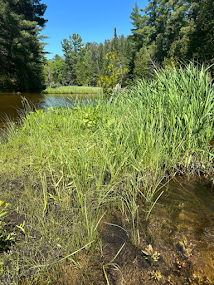Manistee River!
For my 3rd and final blog, I am going to talk about our field trip to the Manistee River. The Manistee River is located in the northern half of Michigan’s lower peninsula. It is about 26 miles long with recreational options available to the public (Rivers.gov). Some of those include kayaking/canoeing and fishing. In our case we did aquatic insect collecting!
During this trip we were looking
for caddisflies, mayflies, stoneflies and any other aquatic insect. I specifically
was looking for caddisfly nymphs. Since we were looking for aquatic insects, we
brought aquatic nets, and we also brought some arial nets in case we saw any flying
insects. This river, like most here in Michigan was very sandy. The middle
section of the river was mostly sand with some patches of silt. The banks had a
lot more silt mixed in with the sand making a very thick soil type. The thick
silt plus traveling upstream made it difficult to walk at times, some of us
getting stuck in the process. There were multiple microhabitats in this river
housing a wide range of incest species. The first microhabitat I visited was near
the bank about 60 yards upstream from where we entered the river. This specific
area was really interesting because there was a U-shaped pool cut out of the
bank. It was maybe 2 feet across and about 1 foot deep. When I sampled this pool,
I found 2 armored mayflies. This part of the river really intrigued me because
this was the only spot I saw that had a U shaped cut out in the bank. It makes
me wonder what caused that to happen and if there are other insects living there.
Working farther upstream I came across woody debris in a shallow portion near
the U-shaped pool. The water was really clear, so it was easy to see if there
were any insects on the logs. Fortunately, there were tons of caddisfly nymphs
scattered across the wood. Most of the caddisflies were in cases of varying
compositions. I collected two with
square shape cases made of twigs and two with tubular cases made with vertical
twigs of varying lengths. I identified the square cased caddisflies as Trichoptera
brachycentridae or commonly known as the Humpless Case Maker Caddisfly (Voshell
2003). The species with the vertically oriented twigs is known as the Northern
Case Maker Caddisfly or Trichoptera limnephilidea. Both caddisfly
species are pictured below.
After collecting my caddisflies, I ventured to the opposite side of river which housed more aquatic vegetation. This can be seen in the picture below.
 Aquatic Plants, original pictures by me!
Aquatic Plants, original pictures by me!Here I sadly did not collect any insects, but
I did see a few whirligig beetles and some water striders. From here I went to
a small island in the middle of the river that held a large tree stump and some
fallen logs. The stump was partially underwater so I decided to sample around
it to see if I would find anything new. First, I found another caddisfly nymph,
but this one was much larger than the previous ones. This caddisfly is pictured below. Around this same area I found a stonefly nymph as well.
Trichoptera Phryganediae, Large Caddisfly, original picture.
This was by far my favorite trip because of how pretty the scenery was and the different microhabitats all around. I really loved how there were multiple different areas fairly close together that could be sampled. I was looking specifically for caddisflies on this trip which is why I didn’t collect a variety of insects. I would really like to go back one day and sample again to see what else lives in this aquatic habitat. I would also like to do more terrestrial collecting here since I didn’t do any of that. From what I remember there was a large diversity of vegetation around so I can assume that lots of different organisms are present there as well. I highly recommend venturing this river to anyone that visits!
Sources
Voshell, J. R. (2003). A guide to common freshwater invertebrates of North
America. McDonald & Woodward Pub.






Comments
Post a Comment